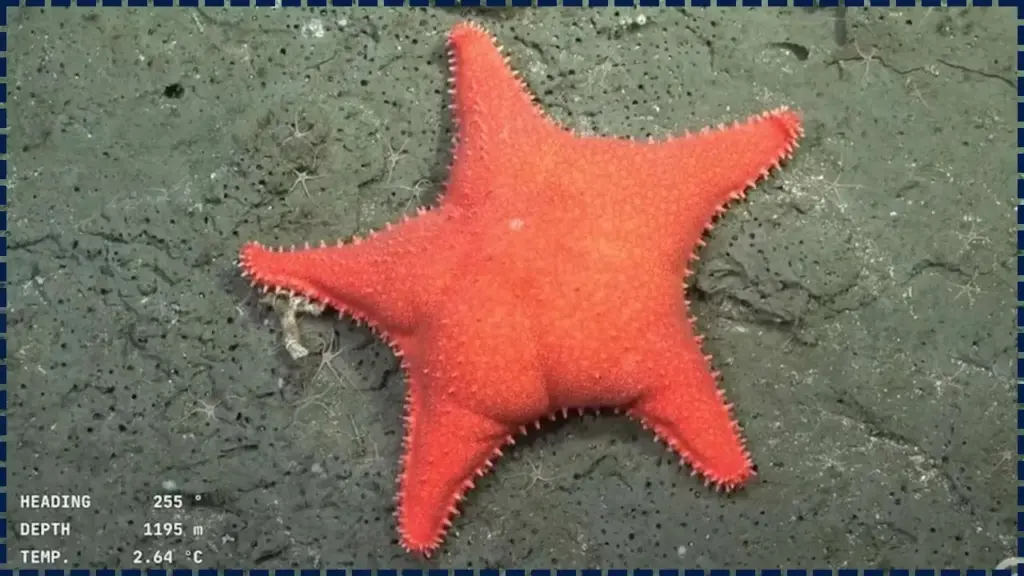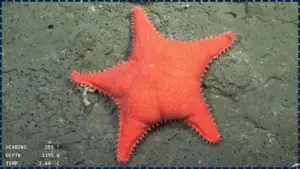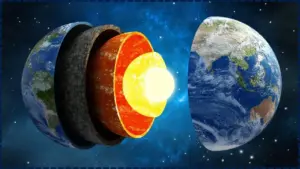During a recent Schmidt Ocean Institute expedition off the coast of Argentina, researchers operating a remotely controlled submersible encountered a peculiar starfish unlike any previously catalogued. The creature, observed at a depth of around 4,000 meters, appeared to have an unusually plump body and short, tapered arms.

Table of Contents
Unusual Starfish Found Deep in the Atlantic
| Key Detail | Description |
|---|---|
| Location | Mar del Plata Submarine Canyon, South Atlantic Ocean |
| Depth of Discovery | ~4,000 meters (13,100 feet) |
| Possible New Species | 40+ newly observed deep-sea species |
| Research Vessel | Schmidt Ocean Institute’s R/V Falkor (too) |
| Focal Organism | A rounded, thick-bodied starfish of the genus Hippasteria |
A Strange Discovery in the Deep
The starfish, tentatively classified within the genus Hippasteria, quickly drew attention for its distinctive shape—earning the informal nickname “big-butt starfish” from online viewers. Yet to scientists, it represents far more than a visual oddity.
“It may not just look strange—it might actually be something entirely new,” said Dr. Mariela Romanelli, curator of invertebrates at Argentina’s National Museum of Natural Sciences. “At that depth, every discovery is a potential first encounter.”
What Makes the Discovery Significant
A Window into the Hidden Atlantic Ecosystem
The starfish was filmed in the Mar del Plata Submarine Canyon, a vast underwater valley carved along the South Atlantic seafloor. The canyon lies at the convergence of two powerful currents—the warm Brazil Current and the cold Malvinas Current—creating a nutrient-rich zone teeming with deep-sea life.
Expedition lead Dr. Daniel Lauretta explained that the ecosystem supports an exceptional range of organisms, from deep-sea corals to previously unknown crustaceans. “This region is one of the most productive and least studied marine areas on Earth,” Lauretta told Scientific American.
The canyon’s complex topography and isolation make it a likely refuge for unique species. The discovery of the starfish and over 40 potential new species could reshape scientific understanding of South Atlantic biodiversity.
Morphology and Mystery
Unlike most known Hippasteria species, which have flat, symmetrical arms and visible surface spines, this specimen appears inflated and smooth. Researchers suspect its odd shape could stem from adaptation to high-pressure, low-light environments.
Others believe its rounded form might be deceptive—possibly due to its feeding state or body orientation when filmed by the remotely operated vehicle (ROV).
“It’s tempting to label every new form as a new species,” said Dr. Jonathan Flores, a marine biologist at Argentina’s National Scientific and Technical Research Council (CONICET). “But in deep-sea biology, confirmation requires genetics, morphology, and patience. Taxonomy in the abyss moves at a glacial pace.”
The Bigger Picture: Why Deep-Sea Discoveries Matter
The starfish’s discovery underscores a broader scientific truth: much of Earth’s biodiversity remains unseen. Despite covering over 70 percent of the planet, less than 20 percent of the ocean floor has been mapped at high resolution, according to the National Oceanic and Atmospheric Administration (NOAA).
Deep-sea organisms also play a vital role in global carbon cycles and ocean health. Their feeding and waste contribute to nutrient redistribution, while many possess biological traits with potential biomedical applications.
“This is not just about curiosity,” noted Dr. Karen Osborn, a zoologist at the Smithsonian’s National Museum of Natural History. “Every new organism adds a piece to the puzzle of how life adapts to extreme environments—information that could inform everything from climate models to materials science.”
Environmental and Ethical Dimensions
As exploration accelerates, scientists warn that deep-sea ecosystems face rising risks. Increased interest in deep-sea mining, oil exploration, and trawling could disrupt fragile habitats before they are even documented.
Marine ecologist Dr. Henry Alston from the University of Exeter observed, “We’re racing to understand ecosystems that are already under pressure. Discoveries like this starfish highlight both the potential and the urgency of protecting the deep ocean.”
Argentina’s Ministry of Environment has since indicated plans to strengthen marine protected zones near the canyon, pending the expedition’s final biodiversity report.
What Happens Next
Back on land, the collected samples are undergoing DNA barcoding and microscopic analysis. Preliminary results suggest the starfish could represent a distinct branch within Hippasteria, but formal classification will take months or even years.
Researchers also intend to compare this species’ genome with that of other deep-sea echinoderms to trace evolutionary divergence. If confirmed as new, the starfish would join a growing list of recently identified deep-sea species found through international collaborations between Argentina, NOAA, and the Schmidt Ocean Institute.
“The more we explore,” said Dr. Lauretta, “the clearer it becomes that our planet’s last frontier still holds many surprises.”
Future of Deep-Sea Exploration
The Schmidt Ocean Institute’s mission is part of a wider global effort—aligned with the United Nations Decade of Ocean Science (2021–2030)—to expand human understanding of deep-sea environments. Using ROVs, sonar mapping, and environmental DNA sampling, researchers aim to fill the enormous gaps in marine knowledge.
As technology advances, scientists can explore previously unreachable ecosystems, raising new questions about how species evolve in isolation, survive under immense pressure, and interact within deep ocean food webs.
“Each discovery forces us to rethink the limits of life,” said Dr. Romanelli. “In many ways, exploring the deep sea today is like exploring another planet.”
Global Perspective and Public Fascination
Public response to the starfish discovery has been enthusiastic, if lighthearted. The image went viral after the Schmidt Ocean Institute posted it on social media, attracting both humor and genuine scientific curiosity.
Beneath the memes, however, lies a meaningful reminder: that humanity’s exploration of Earth remains incomplete. “These moments of wonder,” said Dr. Flores, “connect people to science in a way that data alone cannot.”
Related Links
Earth’s Core Just Got More Complex: Discovery of an Innermost Inner Layer – Check Details
Outlook
As the analysis continues, the mysterious starfish stands as both a symbol and a challenge—a testament to the richness of life beneath the waves and a call for responsible stewardship of a fragile, still-unfolding world.
“Our oceans are vast, resilient, and still mysterious,” said Dr. Lauretta. “But their future depends on what we choose to learn—and how we choose to act—right now.”
FAQ About Unusual Starfish Found
Where was the starfish found?
In the Mar del Plata Submarine Canyon, approximately 300 kilometers off Argentina’s Atlantic coast.
How deep was it discovered?
At roughly 4,000 meters (13,100 feet), in near-freezing, high-pressure conditions.
Is it a new species?
Potentially. Scientists are analyzing DNA and morphology to determine if it represents a previously unknown species.



















